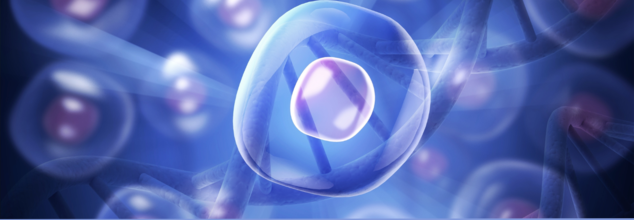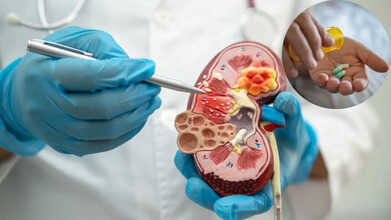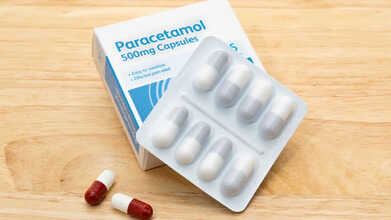- Health Conditions A-Z
- Health & Wellness
- Nutrition
- Fitness
- Health News
- Ayurveda
- Videos
- Medicine A-Z
- Parenting
Between Life And Death, Your Cells Are Conscious- Alive In The Unexpected State Of Being

Image Credits: Canva
The biological process of human life is simple, we're born, we live, and one day we die. But at the cellular level, this apparently simple course is far more complicated. Every human body is a highly complex ecosystem made up of approximately 30 trillion human cells and an equally staggering number of microbes, all functioning together in concert to maintain what we recognize as life.
As researchers discover the cryptic "third state" of life, the question is one of enormity—may near-death experiences have something to do with it? If cells are able to continue and reorganize after an organism has died, could human consciousness do the same in ways we're not yet aware of? Survivors of near-death experiences report vivid dreams, a tunnel vision of light, or a feeling of calm. But what happens to those who don't come back? May their cells be undergoing a change, a try to reorganize in some fashion we haven't yet understood? This brings into question the nature of death, of consciousness, and beyond.
However, new studies indicate that for certain cells, death is not the final act but a precursor to something surprising. This groundbreaking idea—the so-called "third state"—hypothesizes that under certain circumstances, certain cells, even after the death of an organism, may reorganize and form new functions, throwing our basic definitions of life and death into doubt.
The concept of a third state initially gained scientific momentum with the emergence of xenobots—AI-created multicellular creatures that exhibit autonomy outside their initial biological purpose. These small biological robots are constructed from frog embryo cells, which, when introduced into new environments, spontaneously reconfigure and assume new functions. For instance, instead of employing their hair-like cilia to move mucus as they would in a living frog, xenobots redirect these structures for mobility.
This phenomenon proves that cells are capable of being reassembled into new shapes and functions even after the death of an organism. Researchers opine that this postmortem cellular plasticity is not exclusive to xenobots. Human cells, or "anthrobots," also display such actions, proving the ability for posthumous cellular reorganization and transformation.
Are Cells Conscious After Death?
At the center of this controversy stands a challenging query: are cells conscious? Physician and evolutionary biologist William Miller takes on this theory in his work The Sentient Cell, an argument that puts forth the hypothesis that cells enjoy a type of cognitive capacity. The Cellular Basis of Consciousness (CBC) hypothesis proposes that cells do not blindly obey instructions from their genetics but rather are shown to implement decision-making activity, flexibility, and self-conserve mechanisms, all of which are akin to a primitive mode of consciousness.
While classical biological models portray genes as the ultimate controllers, Miller suggests that genes behave more as tools than controllers. Cellular intelligence is instead the driver of cooperation, mutual support, and problem-solving, underpinning multicellular life. This transforms the classical survival of the fittest paradigm to one of survival through collaboration and adaptability.
What Happens to Cells After Death?
Historically, death has been defined as irreversible loss of organismal biological activity. Yet such medical procedures as organ donation illustrate that some organs, tissues, and cells maintain their functional properties even after death—sometimes for hours, days, or weeks under optimal circumstances.
A number of factors will decide whether cells survive after death. Environmental parameters, the state of metabolism, and methods of preservation are all important. Human white blood cells, for instance, can last between 60 and 86 hours from the time of death, while those of mice skeletal muscle can regenerate two weeks after death. Some fibroblast cells in sheep and goats have even been grown up to a month following the organism's death.
In addition, researchers have discovered that certain human lung cells are capable of self-assembling into small multicellular structures that can move and heal themselves. These "anthrobots" exhibit a capacity to explore their environment and repair injured neurons—abilities that contradict traditional assumptions about cellular behavior following death.
How Do Postmortem Cells Work?
Cells' survival following the death of an organism relies on a number of biochemical processes. Some researchers believe that cell membrane specialized channels and pumps act as complex electrical circuits that coordinate cellular communication, organization, and movement. Stress- and immune-related genes also have heightened activity after death, and this implies that cells are striving to make up for lost homeostasis.
Age, health, trauma, infection, and type of species affect the duration of time cells will survive after death. For instance, islet cells in the pancreas, which secrete insulin, are notoriously hard to transplant because of their high demand for energy and susceptibility to attack by the immune system. Uncovering how certain cells resist the process of decay could transform organ transplantation and regenerative medicine.
Can We Harness the Third State for Treatment?
The third state has very significant implications for biotechnology and medicine. Among its possible uses are in personalized medicine, where drugs might be delivered using anthrrobots made from the patient's own cells, to repair tissues or fight diseases.
For example, engineered anthrobots could be programmed to dissolve arterial plaque in atherosclerosis patients or clear excess mucus in cystic fibrosis patients. Unlike synthetic drugs, these living cellular machines would not trigger immune rejection and could biodegrade naturally within weeks, minimizing long-term risks.
In addition, the third state of matter idea might lead to next-generation regenerative therapies, potentially enabling researchers to revive lost functions in injured organs or even extend transplantable organ preservation times. The discovery of the mechanisms behind how some cells are able to survive and adapt following death might also yield essential knowledge on aging, neurodegeneration, and immunity.
As study of the third state increases, it threatens our traditional notions of biology, consciousness, and the very nature of death. If cells are in some sense intelligent, as scientists argue, then life itself must be redefined. What we might view as the "end" is merely a stage of biological change, in which cells rearrange themselves and accommodate different functions in a manner previously unknown.
The applications of this study go far beyond the realm of medicine; they border on philosophical and ethical considerations regarding consciousness, identity, and the very nature of what it means to be alive. As science continues to peel away layers of cell behavior, one thing remains for sure—life, as we have always known it, is much more complex and mysterious than we have ever conceived.
More than Just Near-Death Experiences
This study also opens up an interesting possibility: might near-death experiences have something to do with the third state? Researchers have long reported instances of people having vivid, life-changing experiences at the time of clinical death—seeing light, meeting dead relatives, or feeling themselves float above their bodies. If cells are still able to function and reorganize after death, might this activity be responsible for these experiences, rather than just hallucinations?
Some scientists now question whether such experiences are a cellular-level phenomenon even in individuals who cannot be resuscitated. If cells preserve some sort of consciousness or decision-making capacity after biological death, it would change our concept of both consciousness and the line between life and death.
The third stage between life and death is no longer an outlying theory—it is a phenomenon witnessed by scientists with far-reaching medical, ethical, and philosophical consequences. While scientists continue to study how cells survive and change following the death of an organism, our perception of life itself may be poised on the verge of a paradigm shift.
Scromiting: What Is This Severe Vomiting Syndrome Linked To Long-Term Cannabis Use

Credits: Canva
For many long-term cannabis users, the usual jokes about the munchies feel far removed from reality. Over recent years, emergency rooms have reported a steady rise in regular smokers arriving with sudden bouts of severe stomach distress that leave them curled up and unable to function. What makes it more troubling is that these episodes return several times a year, often leaving both patients and clinicians unsure of what is going on.
Scromiting: What is Cannabis Hyperemesis Syndrome (CHS)?
The source of the problem is cannabis hyperemesis syndrome (CHS), a difficult condition marked by unrelenting nausea, strong abdominal cramps and repeated vomiting that can occur four or five times an hour, according to the Cleveland Clinic.
What Is Scromiting?
Symptoms usually appear within a day of cannabis use and can linger for several days. These episodes can be so overwhelming that emergency staff have adopted the term “scromiting,” a blend of screaming and vomiting that captures how distressing it can be.
Although cases have become more common, many healthcare workers are still relatively unfamiliar with CHS because it was only identified in recent years. This makes it easy to confuse with other illnesses such as foodborne infections or stomach bugs.
“A person often will have multiple emergency visits before the condition is correctly identified, which can be very costly,” said Dr. Beatriz Carlini, a research associate professor at the University of Washington School of Medicine who studies the health risks linked to cannabis. Once a diagnosis is made, managing the condition can still be a challenge.
There are no approved treatments at present, and many standard nausea medications fail to bring relief, explained Dr. Chris Buresh, an emergency medicine physician with UW Medicine and Seattle Children’s Hospital.
This often pushes doctors to try less common options, including Haldol, a drug usually used to manage psychosis. Some people experience temporary improvement from applying capsaicin cream to the abdomen, as the warming sensation can help lessen discomfort for short periods.
Hot baths and showers are another frequent source of relief. Many patients report staying in the bathroom for long stretches to calm their symptoms.
“That is often something that helps confirm the diagnosis for me,” Buresh said. “People say a hot shower is the only thing that brings any comfort, and they end up using all the hot water in the home.”
Scromiting Recovery Challenges
Once the worst phase passes, long-term improvement is not always straightforward. Because CHS comes and goes, some cannabis users assume an episode was caused by something else and continue smoking, only to fall ill again, according to UW researchers.
Even for those who accept the diagnosis, quitting cannabis can be difficult due to dependence, which prolongs the cycle of nausea and vomiting, Carlini said. The only known cure is to stop cannabis use entirely.
Researchers still do not know the exact biological cause of CHS. The leading idea is that years of heavy cannabis use overstimulates receptors within the endocannabinoid system, which may disrupt the body’s usual control over nausea and vomiting, as outlined by the Cleveland Clinic.
Why this affects certain users and not others remains unclear. “We do not yet know if it is tied to wider access to cannabis, higher THC levels, or something else entirely,” Buresh said.
“There seems to be a point at which people become vulnerable to this condition, and that point varies from person to person,” he added. “Even small amounts of cannabis can trigger vomiting once someone crosses that threshold.”
A study released earlier this year by George Washington University researchers examined 1,052 people with CHS to learn more about potential risk patterns.
The findings showed that those who began using cannabis at younger ages were more likely to return to the ER with hyperemesis episodes. Many reported daily use and long-term consumption, with 44 percent using cannabis regularly for more than five years before symptoms began.
CHS is not limited to adults. Data shows that emergency visits among American adolescents have increased more than tenfold between 2016 and 2023. While overall rates tend to be higher in states where recreational cannabis is legal, the sharpest year-to-year rise in adolescent CHS cases has been recorded in states where recreational use is still against the law.
Kidney Risks For This Widely Used Blood Pressure Medicine, Says NHS

Credits: Canva
People who rely on a commonly prescribed medicine may face a kidney-related side effect that needs medical attention. This drug is routinely used for high blood pressure and heart failure, and doctors often prescribe it after a heart attack. In 2024 alone, it was issued 34.8 million times. Beyond lowering the risk of future heart attacks, strokes, and kidney problems, it also improves survival when taken for heart failure or after a cardiac event. But which medicine raises this concern?
NHS ‘Kidney’ Warning For People Taking Ramipril
Ramipril (sold under names such as Altace, Vostally, Tritace, Cardace) belongs to a group of medicines called ACE inhibitors. Doctors use it to treat a range of heart and blood vessel problems because it relaxes and widens the arteries, easing pressure on the heart and reducing blood pressure. It is usually taken as a tablet, capsule, or liquid. Although ramipril is helpful for many people managing long-term blood pressure or heart issues, it can occasionally trigger side effects. Some reactions may be strong enough to require urgent medical help.
Is Ramipril a Beta Blocker?
Ramipril is not a beta blocker. It belongs to a group of medicines called ACE inhibitors. Both ACE inhibitors and beta blockers are used for blood pressure and heart problems, but they do not work the same way.
How Ramipril Works (ACE Inhibitor)?
Ramipril stops the body from making a certain enzyme known as ACE. When this enzyme is blocked, the body produces less angiotensin II, a hormone that normally tightens the blood vessels. With less of this hormone active, the blood vessels stay more open, which lowers blood pressure and helps blood move through the body more easily.
Ramipril Side Effects
Not everyone who takes ramipril will feel unwell, yet it can cause problems for certain users. NHS advice notes that long-term use may reduce how well the kidneys work. For that reason, anyone on ramipril may need routine blood tests so that their doctor can keep an eye on kidney function.
More common side effects, which may affect more than one in a hundred people, include:
- A light skin rash
- Blurred eyesight
- A dry or tickly cough
- Diarrhoea
- Vomiting
- Headaches
- Feeling faint or dizzy
Ramipril can also lead to more serious issues, though these are rare. These include:
- Kidney concerns shown by blood in urine, little or no urination, or puffy ankles
- Possible bone marrow problems such as unusual tiredness, frequent bruising, dizziness, or fever
- Yellowing of the skin or eyes, which can suggest a liver problem
- Severe pain in the stomach
In rare situations, ramipril can cause a serious allergic reaction known as anaphylaxis. The NHS advises seeking emergency help if this happens. Signs include:
- Swelling of the lips, throat, or tongue
- A tight throat or trouble swallowing
- Sudden confusion
- Fainting and not waking up normally
- Blue, grey, or pale skin, lips, or tongue
- Very rapid breathing or difficulty breathing
More information about ramipril is available on the NHS website. Always speak with your doctor before beginning or stopping any prescribed medicine.
Before You Take Paracetamol, NHS Advises These Five Groups To Check With A Doctor

Credits: Canva
If you begin to feel feverish or run down with body aches, your first instinct may be to take paracetamol. Known for easing a wide range of day-to-day pains, it remains one of the most commonly bought medicines in the UK, with roughly 200 million packets sold over the counter each year. Even so, it is not suitable for everyone. Some people are advised to speak to a doctor or pharmacist before using it to avoid unwanted reactions. The NHS notes that this is particularly important for anyone who has had an allergic response to medicines in the past, including paracetamol, as well as people with existing kidney or liver concerns.
What Is Paracetamol?
Paracetamol, also called acetaminophen and sold under familiar names such as Tylenol, Panadol, or Calpol, is an everyday pain and fever medicine. It works by easing discomfort and bringing down raised temperatures, which is why many people take it at the first sign of illness.
Those who should seek medical advice before using it include:
- People taking certain prescription drugs
- Anyone who has liver or kidney problems
- People who drink more alcohol than the advised weekly limit of 14 units
- People who weigh under 50kg, as they may need a lower dose
- Anyone with a past allergic reaction to paracetamol or another medicine
Paracetamol: NHS Guidance
More guidance from the NHS states: “Paracetamol is a common painkiller used to treat aches and pain. It can also be used to reduce a high temperature. It's available to buy from a pharmacy or shop, but you may be able to get 1g tablets on prescription if you have long-term pain.
“It comes as tablets, capsules, syrup, powder to mix with water, or as suppositories. The 1g tablets are only given on prescription. Paracetamol is also found in combination products that include other pain or anti-sickness ingredients. It is included in many cold and flu medicines.”
Paracetamol Use: When Extra Caution Is Needed
Paracetamol can usually be taken safely with most antibiotics and prescription treatments, though there are exceptions. People prescribed warfarin to reduce clotting risk or medicines used for epilepsy or tuberculosis, should check with a doctor before taking them.
With regard to other painkillers, the NHS explains: “It's safe to take paracetamol with other types of painkiller that do not contain paracetamol, such as ibuprofen, aspirin or codeine. Do not take paracetamol alongside other medicines that contain paracetamol. If you take two different medicines that contain paracetamol, there's a risk of overdose.”
For most adults, the standard dose is two 500 mg tablets up to four times in 24 hours, with at least four hours between each dose. No more than eight tablets should be taken in one day.
Although paracetamol remains a reliable option for most people, these reminders follow a study from the University of Nottingham that raised concerns about long-term use. The research, published last November, warned that repeated dosing in older adults may increase the risk of heart issues, stomach complications, and kidney problems.
Researchers examined the medical records of 180,483 people aged 65 and above who had been prescribed paracetamol and compared them with 402,478 people of similar age who had not taken it. The findings suggested that “prolonged paracetamol usage” could raise the likelihood of “serious complications,” including heart failure, raised blood pressure, gastric ulcers, and chronic kidney disease.
Because of this, the authors called for a “careful reconsideration” of paracetamol as the first option for managing long-term pain.
Lead researcher Professor Weiya Zhang commented, as per The Miiror, “Whilst further research is now needed to confirm our findings, given its minimal pain-relief effect, the use of paracetamol as a first-line pain killer for long-term conditions such as osteoarthritis in older people needs to be carefully considered.”
For more detailed guidance, consult the NHS website. Always check the packaging when using products such as Disprol, Hedex, Medinol, Panadol, or any other medicine that contains paracetamol, as the dosage and instructions can differ.
© 2024 Bennett, Coleman & Company Limited

